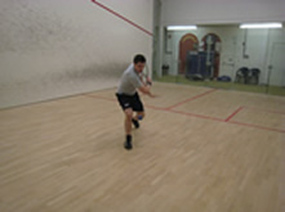
The narrow cross court is a great attacking option for Racketball.
With the narrow cross court it’s unlikely that you will make an error and it’s possible that you will hit an outright winner. This shot has a great application to Racketball.
The main reason for this shot being so effective in Racketball is that despite the fact that the aim of the shot is to go straight through the middle of the court. In Racketball it is tough for your opponent to hold the middle of the court and volley due to the speed and weight of the ball. This means that it is likely that the ball will travel past your opponent and into the back corner.
With the narrow cross court it’s unlikely that you will make an error and it’s possible that you will hit an outright winner. This shot has a great application to Racketball.
The main reason for this shot being so effective in Racketball is that despite the fact that the aim of the shot is to go straight through the middle of the court. In Racketball it is tough for your opponent to hold the middle of the court and volley due to the speed and weight of the ball. This means that it is likely that the ball will travel past your opponent and into the back corner.
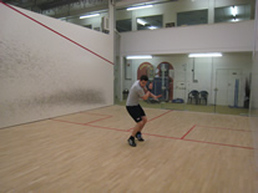
The narrow cross court is directly applicable to two of the four main tactics for winning rallies in Racketball.
The advantage to the narrow cross court over a normal cross court when hitting into space is that you take out the side walls. When the ball hits the side wall it not only slows the ball down but it also automatically makes the ball bounce up. With the narrow cross court you are aiming to send the ball as directly as possible straight into the back corner. If your opponent is out of position this might be an excellent opportunity to win the rally.
One of the best and most reliable ways to hit an outright winner in racketball is with a tight shot that is difficult to get off the wall. This is what you aim for with every straight drive and this shot gives you the chance to play the clinger (ball that runs right along the side wall) off the cross as well as the straight drive.
The advantage to the narrow cross court over a normal cross court when hitting into space is that you take out the side walls. When the ball hits the side wall it not only slows the ball down but it also automatically makes the ball bounce up. With the narrow cross court you are aiming to send the ball as directly as possible straight into the back corner. If your opponent is out of position this might be an excellent opportunity to win the rally.
One of the best and most reliable ways to hit an outright winner in racketball is with a tight shot that is difficult to get off the wall. This is what you aim for with every straight drive and this shot gives you the chance to play the clinger (ball that runs right along the side wall) off the cross as well as the straight drive.
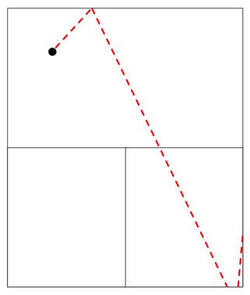
This shot can be hit with your normal technique. Note that unlike on a crosscourt where you might be adding in extra cut to make the ball bite on the side wall with this shot you are able to send the ball forward without the extra cut. The narrow cross court needs to hit the front wall at a much narrower angle (closer relatively to the striker).
It’s best to hit the ball low and flat which will make it even more difficult to get the ball out in the back corners.
Aim to hit the floor then the back wall and let the ball run along the side wall. If you take the ball in a normal position at the front of the court aim for the edge of the service box and if you get the angle right as shown in the diagrams bellow then from almost any position you can hit an outright winner.
If you are looking for a winner into open space try to cut the pace off the ball and think about your weight of shot so that the ball does not rebound off the back wall.
It’s best to hit the ball low and flat which will make it even more difficult to get the ball out in the back corners.
Aim to hit the floor then the back wall and let the ball run along the side wall. If you take the ball in a normal position at the front of the court aim for the edge of the service box and if you get the angle right as shown in the diagrams bellow then from almost any position you can hit an outright winner.
If you are looking for a winner into open space try to cut the pace off the ball and think about your weight of shot so that the ball does not rebound off the back wall.
The shot can be played from the front or the back of the court and hopefully the photos and diagrams below should help this description make sense. As Racketball rallies go on for a long time it’s important to have as many options as you can.
When trying this shot out for yourself, get used to varying the width of your cross court so you can hit a wide cross court and go for the nick when you want but also have the narrow cross court to use when you are backing yourself for a winner. Hopefully this makes sense and the narrow cross court can become a useful part of your arsenal.
When trying this shot out for yourself, get used to varying the width of your cross court so you can hit a wide cross court and go for the nick when you want but also have the narrow cross court to use when you are backing yourself for a winner. Hopefully this makes sense and the narrow cross court can become a useful part of your arsenal.
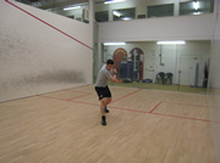
Step 1:
Notice the racket is prepared early behind my head.
You will want to be well balanced when striking the ball.
If you do not need to disguise the shot keep your knee roughly facing the corner between the front and side walls.
Your shoulders should be facing the side wall ready to release the racket through the ball.
Notice the racket is prepared early behind my head.
You will want to be well balanced when striking the ball.
If you do not need to disguise the shot keep your knee roughly facing the corner between the front and side walls.
Your shoulders should be facing the side wall ready to release the racket through the ball.
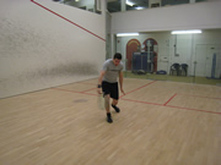
Step 2:
Make the racket strikes the ball in front of your body to ensure maximum momentum transfer.
The body should stay solid as you strike the ball with only a small shoulder movement and no movement in the body.
Make the racket strikes the ball in front of your body to ensure maximum momentum transfer.
The body should stay solid as you strike the ball with only a small shoulder movement and no movement in the body.
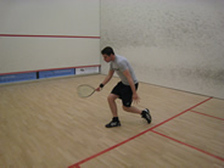
Step 3:
After striking the ball hold your position for a fraction of a second
Point the racket towards the corner of the front wall
After striking the ball hold your position for a fraction of a second
Point the racket towards the corner of the front wall

